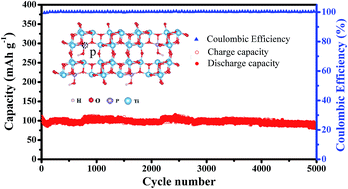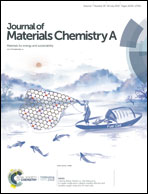An interlayer defect promoting the doping of the phosphate group into TiO2(B) nanowires with unusual structure properties towards ultra-fast and ultra-stable sodium storage†
Abstract
Heteroatom doping is an effective way to modulate the local structure of TiO2-based materials, enabling enhanced electrochemical performance. However, current studies generally adopt a single atom doping strategy, and ionic group doping has rarely been achieved and is a distinctly bigger challenge. Herein, doping of the phosphate group at high concentrations into blue TiO2(B) nanowires is proposed and realized for the first time by skillfully utilizing the defects induced during the dehydration and topology transformation process of the H-titanate precursor; based on experimental characterization and first-principles calculations, it has been demonstrated that this material possesses exceptional electrical properties, a remarkably reduced band gap, magnetic characteristic from the extra electrons outside the Ti atomic nucleus and remarkable phase stability. Benefiting from the unusual structure properties, phosphate-doped TiO2(B) exhibits the ultra-fast sodium storage capability of 124 mA h g−1 at the extremely high rate of 50 A g−1 and excellent long cycling stability even at 10 A g−1 after 5000 cycles. Moreover, this electrode material was tested at low temperatures and exhibited comparable reversible capacity and outstanding cycling stability to those at normal temperatures. We also assembled a B–TiO2(B)–P//(NVPF) full cell, which delivered the maximum energy density of 170 Wh kg−1 and the maximum power density of 5000 W kg−1.



 Please wait while we load your content...
Please wait while we load your content...